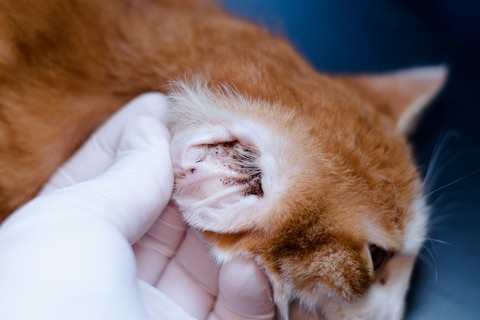Everything, Cats, Dogs, Health care
Cat and Dog Ear problems: Ear Mites and Infections
Fluffy and Fido are scratching, shaking, and rubbing their heads and ears. It looks like ear mites…or ear infections. Both are common with cats and dogs, but how can you tell the difference, and what can you do about the problem?
Identifying your dog’s or cat’s ear problem
Commons signs of an ear problem:
- Ear scratching and rubbing
- Redness or scabs around the ears
- Frequent head shaking or tilting
- Pain when you touch the dog’s or cat’s ears
- A bad odor coming from the ears
Ear mites are more common with cats, particularly young cats and kittens, but mites live on dogs too. Ear mites produce dark-colored wax and dried blood — look for dark specks resembling coffee grounds in your pet’s ears. Mites can also live on other parts of an animal’s body. When mites feed on the skin surface, inflammation results. This can cause infections and possibly even ruptured eardrums and hearing loss if left untreated.
Bacteria, yeast, allergic reactions, wax build-up, foreign objects, and matted ear hair are other causes of ear infections. Less commonly, a polyp (tumor) or drainage problem may be the cause. Ear infections from causes other than ear mites are more common in dogs than in cats. Wax from infections and allergies is often a lighter color; head tilting and balance difficulties may indicate a middle ear infection.
Dogs with long, floppy ears are more prone to ear mites and ear infections than are dogs with straight ears. Floppy ears decrease ventilation.
When you suspect ear mites or an ear infection, have your veterinarian examine your pet to diagnose the problem. Your veterinarian will observe the type of ear discharge and check to see if a middle or inner ear infection is present.
Treating ear mites
Your veterinarian will clean out the debris in your cat’s or dog’s ears. The usual treatment after the ear cleaning is with ear drops that kill the mites and prevent secondary infections. Treatment needs to be continued for at least three to four weeks to kill developing as well as adult mites. Even if you see evidence of mites in only one ear, treat both ears as mites can travel.
Ear mites can live on other parts of your pet’s body, not just in the ears. In addition, ear mites can spread to other cats and dogs in your household, as well as to rabbits, ferrets, hamsters, and other mammals. While they don’t live on humans, you may find them on your skin after handling your pet, or they may hitch a ride on you on the way to another animal. If one animal in your household has ear mites, it’s a good idea to assume that others do too, and to treat the pets and living areas accordingly.
Many commercial flea and tick products kill mites. In addition, some commercial products are designed specifically to eliminate ear mites. However, these ingredients may contain insecticides. See “Are Topical Flea Treatments Safe?” for concerns about using insecticides on pets. The alternative methods suggested in that article will help eliminate your home’s mite population as well as any fleas.
The ear drops that your veterinarian provides may also contain insecticides. However, oil-based home remedies can kill mites by covering their breathing pores, and most of them are non-toxic. Dr. William Pollak, DVM, recommends a mixture of one-half ounce of almond oil or olive oil and 400 IU of Vitamin E to start, followed by diluted tincture of yellow dock (a herb). See Dr. Pollack’s article “Natural Treatment for Ear Mites” (in PDF format) for specifics on this treatment. Avoid tea tree oil as it can be toxic for humans, dogs, and especially cats. Some animals appear to be more sensitive to it than others. If you do use it, dilute it with other oils.
Home remedies can eliminate ear mites, but antibiotics are needed to treat any secondary ear infections. Corticosteroid drugs can help relieve the itching until the mites are gone.
Treating ear infections
Your veterinarian will clean the debris from your pet’s ears. Sedation may be required for this step, and in severe cases, surgery. Medication may be necessary, and you may need to clean your pet’s ears daily until the infection is gone. Your veterinarian can show you how to clean your pet’s ears properly. During this time, you should prevent water from going in the pet’s ears.
Regular disinfecting ear washes can help dogs with chronic ear infections. Avoid vinegar, which can irritate the ears, and cotton swabs, which can push ear discharge and infection into the ear canal.
If the infection persists despite treatment, or recurs, look for causes of infection. A blood test, for example, can determine if your dog or cat has any allergies. Animals with diabetes, a suppressed immune system, an autoimmune disease, or thyroid disease are more susceptible to infections.
A final word
Have your veterinarian diagnose your dog or cat at the first indication of ear problems. Even if you use home-based remedies, you want to be sure that you’re treating the right condition. An untreated infection can lead to more serious problems, and some symptoms of ear mites and ear infections can also be symptoms of other conditions. Detecting the problem and starting treatment early gives your cat or dog the best chance of a fast and easy recovery.

